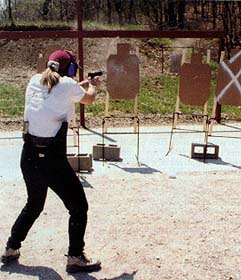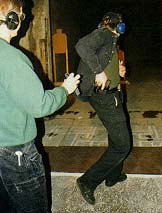


You may hear about IPSC, but how about IDPA? IDPA
carried out another shooting sport similar to IPSC’s match(IPSC) but there
are some differences in nature. Talking about IPSC, it involves the
use of pistol to engage a series of targets in fastest time and highest
accuracy. Pistol used can be mounted with optics in Open Matches,
be ported in Modified Class Matches and be normal carry gun for Limited
Matches. In IDPA’s match (IDPA), the format is similar to IPSC except:
To be more detailed, IDPA is more “realistic” compared with IPSC, you
need to use normal carry gun, daily wore holster to shoot real life simulated
scenarios. There will not be “all targets waiting for you to shoot”
situation in IDPA as sometimes you need to take cover before engaging targets.
There are two types of reloading method. Tactical reload means leaving
no ammunition on the ground after reloading. Shooters need to pouched
his ejected magazine after reloading. The purpose is to top up the
shooters’ ammo before engaging next series of targets. Speed reload
is the other type. Empty magazine can be left after reload, which
is the same as IPSC reloads. These two types of reload is not selective
but will be detailed in course of fire.
Guns used in IDPA are limited as well. There are altogether 4
division of pistol classifications. Their details are as follows:
STOCK SERVICE PISTOL DIVISION
Popular "stock" Double Action/Safe Action factory service pistols such
as the Glock, Beretta, S&W, Ruger, Browning and SIG.
ENHANCED SERVICE PISTOL DIVISION
Popular Single Action 9mm/.38/.40 service pistols such as the Browning
HP, CZ-75, EAA Witness and 1911A1 pattern pistols.
CUSTOM DEFENSIVE PISTOL DIVISION
"Practical" custom 1911 style 10mm/.45 single stack pistols or various
hi-capacity pistols such as the Para-Ordnance, STI/SVI and Glock 20/21
are in this division. There are many out-of-the-box 1911 style pistols
that can be used in this division with little or no custom work.
STOCK SERVICE REVOLVER DIVISION
Common proven service revolvers such as the Smith & Wesson Model
66, 686 or Ruger GP-100 are in this division.
Limitation on gun modifications includes:
THING CANNOT BE DONE
THING CAN BE DONE
The purpose of all these regulations is to promote carry gun only concepts.
If the gun is not suitable for daily carry, it cannot be used in competition.
In fact, most shooters in US IDPA uses their carry gun to compete, which
is the ultimate concept of IDPA.

Scoring system of IDPA is different too. It has two system of
scoring system, Vicker’s count and PAR time. Vicker’s count first
record the time of shooter needed to finish the course (raw time), then
add penalty seconds for accuracy lose to make up the total time.
Shooters with least time will be the winner. For example, assumed
a course with 3 targets. Shooter can gain 15 points (3 targets X
5 points) maximum. If he can only gain 9 points out of 15, the lose
of accuracy (6 points) will be multiply by 0.5 second to make up 3 seconds.
Adding that to the raw time will be the final time.
Standard exercises are often scored on a PAR time basis and final score
will be in points rather than time. Since it is not suitable for "Scenario"
stages, people interested can visit IDPA site to gain more information.
Although there are many new rules, bear in mind that IDPA is a different
competition. IDPA is another competition for shooters who prefer practical
way of target shooting. IDPA is at its initial stage in Hong Kong
and Top Gun Shooting Association is having trials on BBIDPA
(IDPA using air-soft gun). Anyone who is interested can contact DEN
Trinity through e-mail
and we welcome any new comers who want to join this exciting new sport.
